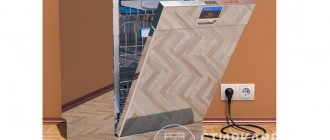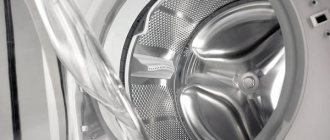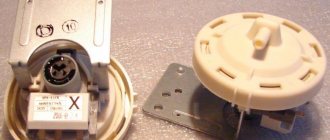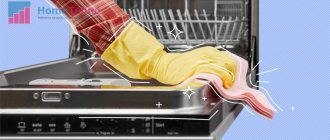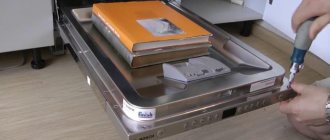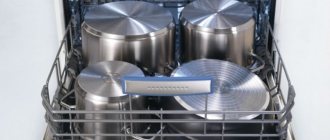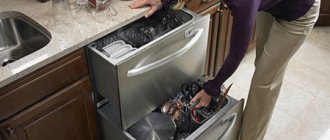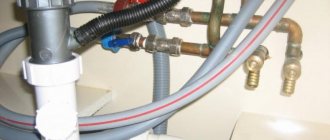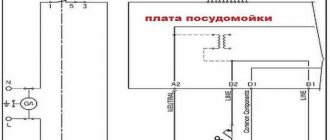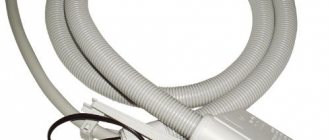Operating a dishwasher involves constant interaction with the door; the machine often needs to be kept open for a long time: to load or unload dishes, clean filters, and add detergents. If the door constantly tries to close, you will have to constantly support it, which is extremely inconvenient.
PMM manufacturers know this, which is why they equip the units with mechanisms that fix the door. However, complaints about the slamming or, conversely, falling door still do not stop coming. Today we will tell you what to do if you have problems opening the dishwasher.
Adjusting the dishwasher door: how to install it correctly
In modern dishwashers, the movement of the door is controlled by a special mechanism that contains springs.
This is done, for example, in Siemens dishwashers. It ensures not only its smooth movement and fixation, but also allows it to be stopped in an intermediate position. If the door malfunctions, if you open it slightly, it may close on its own, creating discomfort when loading the dishwasher. Various breakdowns of this kind more often occur in built-in dishwasher models, for example, from Bosch.
Incorrect operation of a Bosch dishwasher raises many questions. One of the most frequently asked questions is why the dishwasher won't close? An open door does not allow the device to be put into operation, which necessitates troubleshooting. Service center specialists are ready to help solve the problem.
The first sign of a problem is the device does not draw water. Typically, if the door does not close completely or the elements are not tightly connected, the machine will not start the wash cycle even if the programs are working properly.
Key reasons why this problem may occur:
- Incorrect installation of equipment. If the Bosch machine is not level and its body is positioned at an angle, the user will not be able to ensure that the machine door closes tightly and fits snugly against the walls of the chamber. When a similar problem occurs, the dishwasher door simply does not lock in the closed position.
- Overloading the basket. Sometimes the solution to the situation that has arisen lies on the surface. All you have to do is look into the device’s chamber and remove excess dishes. Perhaps this was the reason why the dishwasher door could not be locked.
- Deformation of the seal. A fairly common case is when the rubber that provides a tight connection deteriorates.
- The use of low-quality detergents, which negatively affect the operation of the structure or system as a whole.
- Broken lock. You can check it visually. Also in this situation, it is worth paying attention to the lock control triac on the module. It is worth noting that the lock can completely fail or become dislodged for a specific reason.
- Spring breakage. The door cannot close tightly if the spring is stretched or torn.
The reason may also be the failure of other structural elements. Any malfunction of the Bosch dishwasher requires immediate repair.
What to do if your Bosch dishwasher door is broken?
If the machine breaks down, first you need to check that the dishwasher housing is installed correctly. This can be done using improvised means. Main verification criteria:
- The housing must be located on a hard and level surface.
- Each dishwasher leg must be on the floor covering.
- The location of the dishwasher can be verified using the building level.
Progress
Having gone through all the steps of the preparatory stage, you can begin repair work. You won’t be able to adjust or remove the door right away—you need to start slowly but surely disassembling the PMM. First you need to remove the side walls and the top cover; behind them lies a smooth opening mechanism. No further disassembly is required. Just in case, take notes on the disassembly steps to avoid mistakes:
- Unscrew the fasteners that hold the right side wall. Remove and set aside the panel.
- Repeat the operation for the second wall.
- Unscrew the screws that hold the top cover in place, remove it, and set it aside.
Under the cover you will see two fasteners from which cables extend in different directions. They run along both sides of the body, connecting at the end with the springs. This is what the soft opening mechanism looks like, which needs to be adjusted.
Armed with a hexagon, tighten the screws from which the cables that tension the springs come. If the door opens with difficulty, you need to loosen the tension of the springs, and if the door does not hold, you should increase the tension.
It is much worse if one of the cables bursts from the load. In this case, the second one works for two people, and therefore does not perform the functions assigned to him. Regulation is pointless - you need to replace the damaged element. Proceed as follows:
- loosen the screw that holds the broken cable;
- Use pliers to remove it from the screw;
- disconnect from the spring;
- buy a new original or similar item;
- unpack;
- put the cable on the spring;
- Grab one end with pliers, pull it tight and hang it on the screw;
- adjust the tension;
- assemble the machine.
If the door cannot be adjusted, more serious repairs will be required.
Dishwasher Installation
The dishwasher installation looks like this:
- Carefully study the instructions from the dishwasher in order to correctly understand which water supply to connect it to. The whole point is that some brands work with the supply of hot water and cold water, while others are connected to one water supply.
- Mounting a tee onto a water pipe in order to provide a branch through which the dishwasher will be connected. As a rule, the remaining necessary spare parts are included in the equipment delivery package. However, sometimes their length is not enough. For example, the manufacturer Bosch allows hoses to be extended up to 3.5 m (for models with a width of 45 cm) or up to 3.6 m (for models with a width of 60 cm). The point here is this: some models do not stop the water themselves and therefore require a special valve. Although the previously mentioned manufacturer Bosch (Bosch) and the fairly well-known manufacturer Siemens have equipped all modern models with this function. Important! Regardless of what brand your equipment is (Bosch, Siemens or something else), connection is only possible when the length of the hose through which water will be supplied does not exceed 5 meters.
- The stage of connecting the unit to the drain (direct installation of everything necessary for water supply).
- Connecting the dishwasher to the electrical network. Important! Grounding is required.
- Adjusting the dishwasher. The importance of this stage should not be neglected. It is thanks to the correct adjustment that you can ensure long and productive use of the equipment.
What does the locking mechanism consist of?
First, let's look at the internal structure of the PMM to make it easier to determine the breakdown.
The locking mechanism is located inside the door and consists of the following elements:
- metal spring;
- cable (metal or fabric);
- plastic locking element;
- loops.
Some models, such as Bosch, also have closers that make the door move smoother.
The mechanism of operation of this system is simple. You open the dishwasher and thereby set the hinges in motion. This increases the tension of the cable, and it, after itself, stretches the spring. When the spring is stretched to its maximum, the locking element falls into a special hole and fixes the structure, preventing the spring from closing. At this moment, the PMM can safely be in the open position. As soon as you want to close it and move the door up, the lock will come out of the grooves and allow the spring to slam the door.
That is why PMMs that are not equipped with closers should be held when closing. If this is not done, the door will slam loudly and there will be a jerk that can damage the internal mechanisms or the housing.
Installation instructions for a Bosch machine
Organizations that sell household equipment usually offer installation services. Do not neglect them if you want to maintain the warranty on your new dishwasher. If calling a specialist is impossible for some reason, carefully read the instructions.
It contains diagrams and recommendations on how to properly install a specific model of Bosch dishwasher on your own.
Stage #1 - connection to the sewer
A drain hose is used to connect the washing section of the machine to the sewer pipe. It may be part of the delivery kit, or may be purchased separately. The drainage hose can be smooth or corrugated. The first one gets clogged less, the second one bends better.
We suggest that you do not stop at simply inserting a drainage hose into a sewer outlet, but carry out a number of measures that will subsequently protect the machine and the connected hose from additional repairs and cleaning:
- be sure to use a siphon - this way you will forever get rid of the discomfort caused by the unpleasant odor;
- bending in the form of a loop at a distance of 45-55 cm from the floor will help to avoid reverse flow of water;
- Ensure the connection between the drain and the sewer pipe is tight to eliminate the risk of leaks and flooding.
It is not advisable to fill the connections with sealant - when replacing elements, you will have to remove all the equipment. No less reliable are clamps that evenly tighten the hose around its entire circumference. There are devices with plastic union nuts - they are not as reliable, but with constant monitoring they can ensure tightness for a long time.
To connect the drain of dishwashers for kitchen sinks, siphons are produced with a pipe designed to connect to a hose. They attract with their compact size, optimal shape and convenient system assembly diagram.
So, to connect to the sewer you need:
- fix the drain hose on the outlet pipe of the machine;
- connect the hose to the water seal;
- ensure a sealed entrance to the sewer pipe using an adapter.
Preparing for the adjustment procedure
Before starting work, it is necessary to carry out the appropriate preparation:
- It must be remembered that when making adjustments, you must turn off the dishwasher and also disconnect the power cord from the outlet.
- If we are talking about a built-in dishwasher, such as Electrolux or another similar one, the unit must be removed from the niche.
- Disconnect the hoses that supply water, as well as the drain hoses.
- Before starting work, you will need to prepare the tools that will be used.
- Before carrying out adjustment work, it is useful to familiarize yourself with the instructions for carrying it out.
When disconnecting from communications, it is important to remember the following:
- You need to unplug the dishwasher from the outlet. The wire must be rolled up and hung on a special holder, which is provided in the dishwasher for this purpose.
- It is necessary to close the valve, which will turn off the flow of water from the water supply network to the dishwasher.
- The water intake hose must be completely disconnected from the dishwasher.
- Next, the drain hose is disconnected. After this you need to install a plug.
If a built-in dishwasher model is used, then it is removed from the kitchen furniture set as follows:
- First of all, you need to find the fasteners that hold the dishwasher.
- Using a Phillips screwdriver, you need to remove the screws that hold the car in the niche.
- Next, you need to carefully pull out the car. Typically, the weight of built-in units AEG or others of the same kind does not exceed 50 kg - this makes it possible to move it yourself. In this case, it is necessary to act as carefully as possible.
- Before placing the machine on the floor, you need to prepare a place for this and cover the floor so as not to damage it when moving. The dishwasher should be placed in such a way that it is easily accessible from all sides.
To prepare for door adjustment, you will need the following tools:
- crosshead screwdriver,
- pliers,
- hexagon,
- you need to prepare a metal cable one and a half millimeters thick.
Errors in Bosch and Siemens dishwashers
Sometimes situations arise when the question arises of how to reset the program on a Bosch dishwasher or another model. Cancellation is simple - just press the Start button and hold it for 3 seconds. The indicator lights should go out. After turning off the dishwasher, it will begin draining water. This happens within about 1 minute. But it happens that there is a problem with the dishwasher. Error codes start flashing on the display. In this case, you also need to know how to reset the settings.
Other faults
The most common situations were discussed earlier. However, other damage may occur:
- The door leaf falls when opened. This suggests that the most likely cause is a broken cord or a broken spring. In this case, appropriate replacement is carried out.
- Sometimes the door does not lock when closed. As a result, the dishwasher does not start working. In such a situation, the dishwasher will show an error code on the display. In this case, it is necessary to take the actions indicated in the instructions for this situation.
- If the machine is leaking, one possible reason could be broken cables or a broken spring. When carrying out repairs it is necessary to check them.
- If you hear a strong creaking sound when opening or closing the door, this indicates that the hinges need to be lubricated. It may also turn out that they have become faulty. In this case, they need to be replaced.
Although in the situations under consideration, adjusting the door tension can be done independently, but if the dishwasher is under warranty, it is better to contact a service center.
Introduction to the basic programs of Bosch dishwashers
- Choose a washing program based on the number of dishes and the degree of soiling.
- The automatic mode, using sensors inside the machine, automatically selects the duration and intensity of washing.
If there is a high degree of contamination or for burnt food, the “intensive” mode is suitable. The dishes will undergo soaking and several washing cycles at a temperature of eighty degrees, followed by drying. The Bosch 40E10RU series 2 is equipped with this program. Energy and water consumption will be less if you first remove the main contaminants under running hot water.
